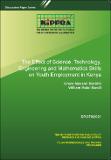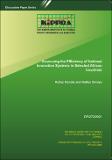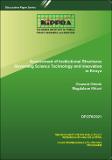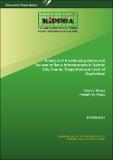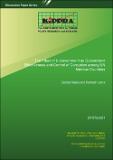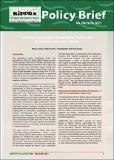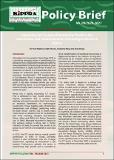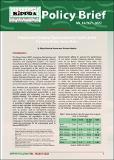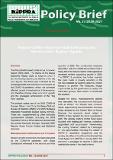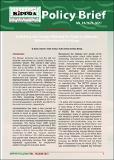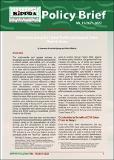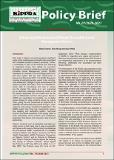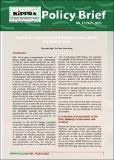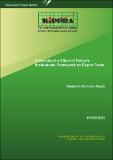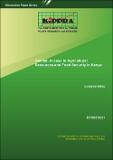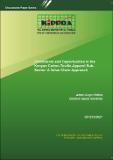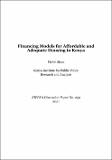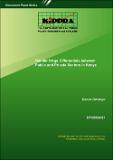3. KIPPRA Research Publications: Recent submissions
Now showing items 181-200 of 707
-
Discussion Paper No. 279 of 2021 on The Effect of Science, Technology, Engineering and Mathematics Skills on Youth Employment in Kenya
(Kenya Institute for Public Policy Research and Analysis, 2021)The choice of the employment sector is influenced by several individuals’ characteristics, among them the Science, Technology, Engineering and Mathematics (STEM) skills. In this study, the paper seeks to determine the ... -
Discussion Paper No. 273 of 2021 on Assessing the Efficiency of National Innovation Systems in Selected African Countries
(Kenya Institute for Public Policy Research and Analysis, 2021)Innovation systems in African countries are largely characterized by low levels of science and technological activities, reliance on government or foreign donor funding, and weak industry linkages. Several efforts have ... -
Discussion Paper No. 274 of 2021 on Effects of Finance Sources on Innovation Activities in Manufacturing Sector in Kenya
(Kenya Institute for Public Policy Research and Analysis, 2021)Innovation in the manufacturing sector is influenced by several factors, including the source of finance. In Kenya, financing of innovation activities has been lacking due to limited financial systems and market to ... -
Discussion Paper No. 276 of 2021 on Assessment of Institutional Structures Governing Science Technology and Innovation in Kenya
(Kenya Institute for Public Policy Research and Analysis, 2021)Science, Technology and Innovation (ST&I) are key for economic transformation of a country and, as such, institutions are necessary for development and promotion of ST&I. Kenya has thus focused on institutional frameworks ... -
Discussion Paper No. 269 of 2021 on Analysis of the Housing Status and Access to Basic Infrastructure in Nairobi City County: Disparities and Level of Deprivation
(The Kenya Institute for Public Policy Research and Analysis (KIPPRA), 2021)Access to basic infrastructure is a key constituent and a prerequisite for affordable housing. Nairobi City County accounts for the highest affordable housing deficit in the country, with roughly 60 per cent of residents ... -
Discussion Paper No. 270 of 2021 on The Effect of E-Government on Government Effectiveness and Control of Corruption among UN Member Countries
(The Kenya Institute for Public Policy Research and Analysis (KIPPRA), 2021)E-government has been implemented by various countries with the aim to improve public sector efficiency through better service delivery, increased accountability and improved interaction between the government, citizens and ... -
Policy Brief No. 08 of 2020-2021 on Exploiting Job Creation Potential for Youth in the Horticulture Industry in Kenya
(The Kenya Institute for Public Policy Research and Analysis (KIPPRA), 2021)The agriculture sector contributed 21.2%, the equivalent of US$ 10.3 billion (2009 constant prices) of the country’s GDP in 2019. Of this, the crops subsector contributed the lion share of 27.8% or US$ 7.58 billion. In the ... -
Policy Brief No. 09 of 2020-2021 on Exploiting Job Creation Potential for Youth in the Information and Communication Technologies Sector in Kenya
(Kenya Institute for Public Policy Research and Analysis, 2021)Information Communication Technology (ICT) is a promising emerging sector in transforming the global economy. Digital technologies are opening new possibilities for developing countries to grow and transform to digital ... -
Policy Brief No. 16 of 2021-2022 on Employment Creation Opportunities for Youths in the Fisheries Sector Value Chain
(Kenya Institute for Public Policy Research and Analysis, 2021)The Kenya Vision 2030 recognizes fish farming and aquaculture as a source of food security, poverty reduction, and employment creation. The various Kenya National Bureau of Statistics (KNBS) economic surveys show that there ... -
Policy Brief No. 21 of 2020-2021 on Kenya in the Covid-19 Era: Fast-Tracking Recovery and Delivery of the "Big Four" Agenda
(The Kenya Institute for Public Policy Research and Analysis (KIPPRA), 2021)This Policy Brief is based on the Kenya Economic Report (KER) 2021. The theme of the Kenya Economic Report 2020 is Kenya in COVID-19 Era: Fast-Tracking Recovery and Delivery of the “Big Four” Agenda. The theme was ... -
Policy Brief No. 10 of 2020-2021 on Exploiting Job Creation Potential for Youth in Industries Without Smokestacks in Kenya
(Kenya Institute for Public Policy Research and Analysis, 2021)The Kenyan economy has over the last two decades experienced an upward trajectory in economic growth. The country’s real Gross Domestic Product (GDP) more than doubled from Ksh 2,150 billion in 2001 to Ksh 5,049 billion ... -
Policy Brief No. 15 of 2021-2022 on Constraints along the Cotton Textile and Apparel Value Chain in Kenya
(Kenya Institute for Public Policy Research and Analysis (KIPPRA), 2021)The cotton-textile and apparel industry is recognized as one of the industries with potential to absorb skilled, semi-skilled, and non-skilled workers within its chain of production. In 1986, the cotton textile and apparel ... -
Policy Brief No. 07 of 2020-2021 on Enhancing Effectiveness of Kenya’s Excisable Goods Management System
(The Kenya Institute for Public Policy Research and Analysis (KIPPRA), 2021)Illicit trade in tobacco products presents significant public policy challenges due to health risks associated with increased access to tobacco products. Further, it contributes to loss of tax revenue and financing of ... -
Policy Brief No. 17 of 2021-2022 on Tapping the Dairy Industry’s Potential to Create Jobs for the Youth in Kenya
(Kenya Institute for Public Policy Research and Analysis, 2021)With the bulging unemployment of youth in Kenya, where about 85% are unemployed, the Kenya Vision 2030 recognizes the dairy industry as one of the fundamental industries in generating employment activities especially for ... -
Discussion Paper No. 256 of 2021 on Assessing the Effect of Kenya’s Institutional Framework on Export Trade
(The Kenya Institute for Public Policy Research and Analysis (KIPPRA), 2021)This study sought to assess the effect of Kenya’s institutional framework in promoting export trade as a channel for long-term growth and economic development as enshrined in the Kenya Vision 2030. Panel data obtained from ... -
Discussion Paper No. 267 of 2021 on Gender, Access to Agricultural Resources and Food Security in Kenya
(The Kenya Institute for Public Policy Research and Analysis (KIPPRA), 2021)Food insecurity is a major development challenge in developing countries. In Kenya, the food poverty incidence remains high, as about 1 in every 3 individuals does not meet the minimum daily calorific requirement. ... -
Discussion Paper No. 253 of 2021 on Constraints and Opportunities in the Cotton-Textile-Apparel Subsector in Kenya: A Value Chain Approach
(The Kenya Institute for Public Policy Research and Analysis (KIPPRA), 2021)The cotton-textile-apparel value chain in Kenya is prioritized for job and wealth creation in the "Big Four" agenda given it is highly labour-intensive. The subsector has, however, performed below expectations, since it ... -
Discussion Paper No. 259 of 2021 on Financing Models for Affordable and Adequate Housing in Kenya
(The Kenya Institute for Public Policy Research and Analysis (KIPPRA), 2021)The study investigates the symbiosis between housing financing and housing sector performance by using household and counties. It establishes that, at county level, uptake of housing loans are inelastic to changes in ... -
Discussion Paper No. 255 of 2021 on Gender Wage Differentials between Public and Private Sectors in Kenya
(The Kenya Institute for Public Policy Research and Analysis (KIPPRA), 2021)An aspect of gender wage gap that is often neglected is the wage differentials between the public sector and the private sector. Cognizant of the fact that the Kenyan labour market is segregated into public and private ... -
Discussion Paper No. 271 of 2021 on The Nexus Between Innovation Gap and Firm Ownership in Kenya: A Gender Approach
(The Kenya Institute for Public Policy Research and Analysis (KIPPRA), 2021)This paper sought to explore the gender gap in innovation among firms in Kenya. The study’s objective was to determine the extent of the gender innovation gap for male-owned and female-owned firms, and the factors ...

